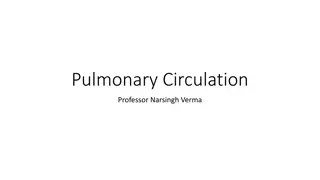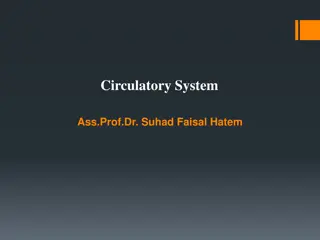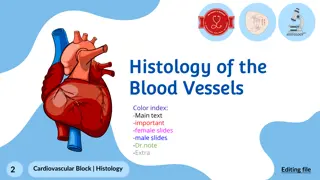Understanding Blood Vessels and Circulation in the Body
Explore the intricate network of blood vessels in the body, including arteries, veins, and capillaries. Learn about the process of blood redistribution and the impact of exercise on circulation. Understand the vital role of the circulatory system in maintaining overall health and physical performance.
Download Presentation

Please find below an Image/Link to download the presentation.
The content on the website is provided AS IS for your information and personal use only. It may not be sold, licensed, or shared on other websites without obtaining consent from the author. Download presentation by click this link. If you encounter any issues during the download, it is possible that the publisher has removed the file from their server.
E N D
Presentation Transcript
1.3 Blood Vessels and Redistribution of Blood Learning Objectives Image AO1: List the different blood vessels found in the body. AO2: Describe the process of the redistribution f blood. AO3: Explain the effects exercise has on the redistribution of blood.
3 1 4 Without looking in your book draw the pathway of blood from memory? 5 2 6
Cardiovascular System This involves the HEART, BLOOD VESSELS & BLOOD. List 5 key facts from the video Why is the circulatory system key to physical education?
Blood vessels Once blood leaves the heart, it is transported around the body in three main types of blood vessels: Arteries Veins Capillaries
Blood vessels Arteries transport the oxygenated blood away from the left side of the heart. The largest artery in the body, connected directly to the heart, is the Aorta. Arteries carry blood under a high pressure.
Blood vessels Veins transport blood from all over the body back to the heart and lungs for re-oxygenation. They are blue because they carry blood that is full of waste products, and are low in oxygen. Veins carry blood under a low pressure.
Blood vessels An unique feature of veins is that they have valves. Remember = Veins have Valves Like the valves in the heart, they are there to prevent a backflow of blood. The blood must flow in one direction only, against gravity in most cases, back to the heart. Image result for valves in veins gif
Blood vessels Capillaries are small blood vessels that carries blood to and from the body s cells. They are one cell thick and are exchange points where oxygen and carbon dioxide cross into the tissue cells (muscles) from the arterioles.
Below is a summary of the differences between arteries and veins? Arteries Veins Take blood away from the heart Take blood to the heart Walls are thin Walls are thick and elastic Transports de-oxygenated blood Transports oxygenated blood Has small lumen Has large lumen Has a pulse and blood travels in spurts Has no pulse and blood travels smoothly Has no valves Has valves
Redistribution of blood during exercise The body uses two mechanisms to control this redistribution. Vasoconstriction (narrowing) and Vasodilation (expanding) is used to redistribute blood to essential areas of the body while decreasing blood flow to others. Answer the following questions... 1. Where is the blood needed during exercise? 2. Where is blood needed just after a meal? 3. What will happen to blood vessels around the muscles?
Redistribution of blood during exercise During exercise, blood flow to muscles increases to meet the increase in oxygen demand. This redirection of blood flow to the areas where it is most needed is known as a vascular shunt.
Set out purposes or reasons (AO2) 1. Explain the function of the arteries in the cardio-vascular system. (3 marks) The purpose of arteries in the cardiovascular system are to 2. Explain the function of the veins in the cardio-vascular system. carry oxygenated blood away from the heart. (1) Its walls are thick and elastic (1) and have no valves as the blood travels at high pressure. (1) (3 marks) 3.Explain how the cardio-vascular system distributes blood when exercising. Circle the command words Underline key information List key words that link to the question. (4 marks)
Set out purposes or reasons (AO2) 1. Explain the function of the arteries in the cardio-vascular system. (3 marks) 2. Explain the function of the veins in the cardio-vascular system. (3 marks) 3.Explain how the cardio-vascular system distributes blood when exercising. Circle the command words Underline key information List key words that link to the question. (4 marks)
1. The purpose of arteries in the cardio-vascular system are to transport oxygenated blood away from the heart (1). They have thick walls and do not any valves (2). The purpose of veins in the cardio-vascular system are to transport deoxygenated blood back to the heart (1). They have thin walls and have valves to stop the backflow of blood (2). The cardio-vascular system redistributes blood around the body in two ways. One was is through vasodilation (1). This is when the blood vessels widen to allow more blood to flow to areas of the body where it is needed the most, for example, the muscles during exercise (2). Another way is through vasoconstriction (3). This is when the blood vessels narrow, restricting the blood flow to areas of the body where it is needed the least. For example, the gut (4). 2. 3. Use these answers to mark your work. Use a different coloured pen























